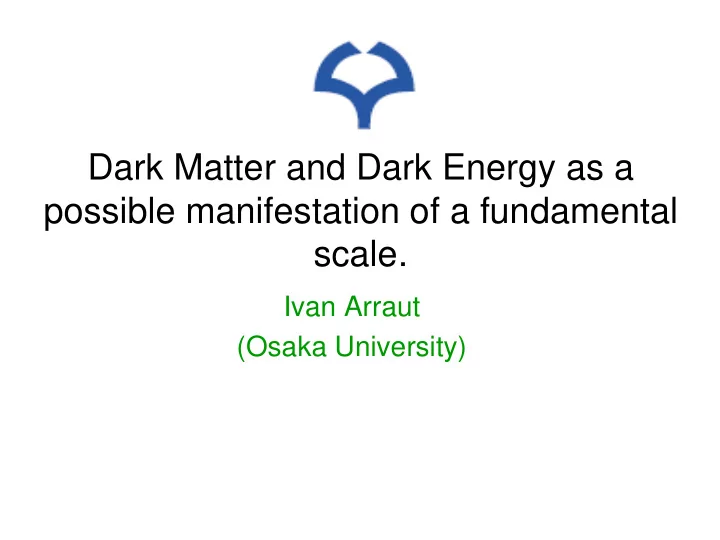

Dark Matter and Dark Energy as a possible manifestation of a fundamental scale. Ivan Arraut (Osaka University)
2 Motivation Question in GR: 1). Why is the cosmological constant so small? 2). Why the velocity of rotation in galaxies is bigger than what is normally expected and what about the Gravitational Lenses? → The project – Find some intermediate interesting scales. – Analyze the importance of such scales. – Find the Einstein’s equations in a new formalism (in process, 3 different paths). – For now the evolution of the parameters is not my bussiness.
Standard GR with Ʌ The Einstein’s eqs. with a Cosmological Constant. • The vacuum solution: • With an effective potential:
• At astrophysical scales.
• Special scale: • The same scale used by Bousso and Hawking for the time- like Killing vector normalization (Hawking radiation). This is not a new scale at all!!! • What about Dark Matter effects? Absent until now. What can we do? • MOND has something to tell us: The fundamental scale in MOND is: • Only one fit parameter. • One interesting prediction of MOND: • Low surface brightness galaxies shows higher discrepancy in the mass content.
→ Problems with MOND – Violation of energy-momentum conservation. – It does not predict gravitational lenses effects. – Problems with the cluster of galaxies. • What can we do? → Possible Solution – Relativistic version derivable from an action principle (many candidates). – Among the possibilities we have: A). Non-localities which can screen the Cosmological Constant but also can create Dark Matter effects. (Sasaki and colleagues. Mashoon).
B). But locality is relative in agreement with Amelino-Camelia, Lee Smolin, Freidel and Kowalzky. Should we pay attention to it? C). But if there is Relative Locality, there should be Relative Co-locality which is a manifestation of the spacetime curvature (Arraut 2012, paper to be submitted soon). D). Another path can be taken with gravity as a gauge theory (in process). • The MOND formula is:
In the full MONDIAN regime, we have: • I am including the repulsive effect due to Ʌ in order to find the bound for the rotation curve. • We can translate the problem. The MOND fit parameter is equivalent to say that the Dark matter scale is:
• Additionally, it is equivalent to say that the Tully-Fisher law in its mass version is valid: • If: • What I propose: Is there any formalism where you can introduce at least 2 scales, one very large and another very small, such that those scales become dual? Rta: q-Bargmann Fock (Quantum groups).
• In the simplest case, the Bosonic algebra is deformed in agreement with: • If we impose as an UV cut-off the Planck scale and as an IR cut-off the Cosmological Constant scale, then:
Minimum, maximum and mix scale • The minimum scales in this model is: Kempf 1994. • The total extremal condition is: • IR-UV mix scale.
The same but taking into account Relative Locality. • Extending the relative locality to the momentum space (the fundamental scale in momentum space taken as Ʌ :
Relative Co-locality (extending the Majid ideas). • The correction to the observed momentum looks like the Tully Fisher law explained before. Can be Dark Matter only an UV-IR mix effect when we extend the Relativity principle to the phase space with a minimum scale in position and momentum?
Open problem and Conclusions. Still we have to verify if this is in reality a manifestation of the Tully-Fisher law and not a mere coincidence. Nex Step (in process). Derive the Einstein’s equations inside this formalism. You should obtain: The standard GR with a Cosmological Constant + some contribution for DM due to UV-IR effect. For now it looks promising.
Acknowledgements 1). Lee Smolin for the bibliograpy suggestions and discussion. 2). Laurent Freidel for the discussion at the P.I about Relative Locality. 3). The friends of the Yukawa Institute, including Prof. Sasaki, Prof. Shiromizu for the kind weekly discussion about different topics. 4). Achim Kempf for his suggestions during the conference in Taipei “Quantum Horizons”. 5). Hagen Kleinert, for the additional submitted references. He has a different point of view.
Recommend
More recommend